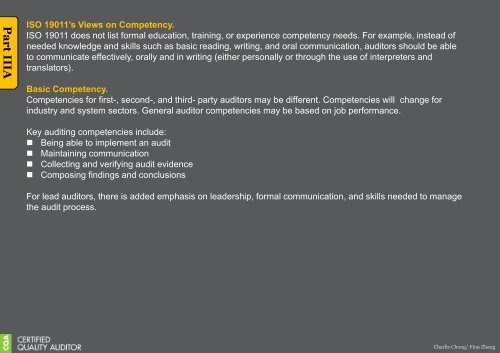My Reading on ASQ CQA HB Part III
Create successful ePaper yourself
Turn your PDF publications into a flip-book with our unique Google optimized e-Paper software.
<strong>Part</strong> <strong>III</strong>A<br />
Auditing Tools<br />
An auditor must be able to comprehend the materials presented during an audit. Some industries and market<br />
sectors have their own language and ways of c<strong>on</strong>ducting business. An auditor may gain this knowledge through<br />
a combinati<strong>on</strong> of work experience and training. For example, the knowledge and experience needed for<br />
auditing a medical facility may be very different from what is needed to audit an educati<strong>on</strong> facility or assembly<br />
plant. Bey<strong>on</strong>d the nominal educati<strong>on</strong> requirements, an auditor needs to understand improvement tools and<br />
techniques to be an effective auditor. Table 10.2 gives example data analysis tools and improvement tools and<br />
programs. <strong>Part</strong> V of the handbook discusses the tools and techniques that a quality auditor should know. These<br />
same topics and tools (such as descriptive statistics, sampling, flowcharts, and diagrams) are relevant to many<br />
other types of auditing.<br />
Envir<strong>on</strong>mental auditors need to know comm<strong>on</strong> envir<strong>on</strong>mental tools such as:<br />
• mass balance,<br />
• risk assessment and probabilities,<br />
• c<strong>on</strong>tingency planning,<br />
• ecosystems, abatement (reducti<strong>on</strong>, ending), and so <strong>on</strong>.<br />
Additi<strong>on</strong>al value- added training is discussed in <strong>Part</strong> IV, “Audit Program Management and Business<br />
Applicati<strong>on</strong>s.”<br />
Charlie Ch<strong>on</strong>g/ Fi<strong>on</strong> Zhang

















